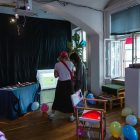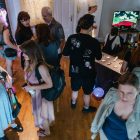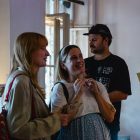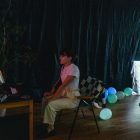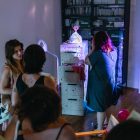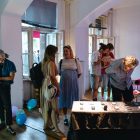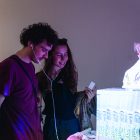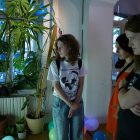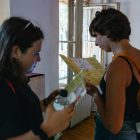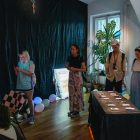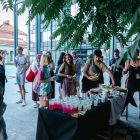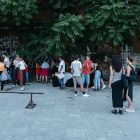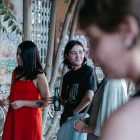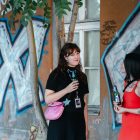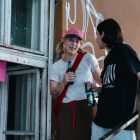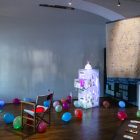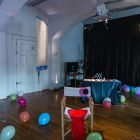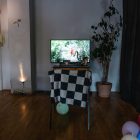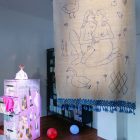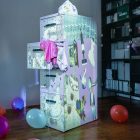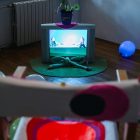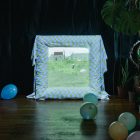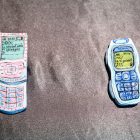FeKK – Ljubljana short film festival
Exhibition
15 – 19 August 2023
Project Room SCCA, Metelkova 6, Ljubljana
Opening: Tuesday 15 August, 7pm (Entrance from the museum platform)
Opening hours: Tuesday – Saturday, 8pm – midnight
Participating: Tjaša Cizej, Jaka Juhant, Ema Kobal, Petra Korent, Klara Kracina, Neo Nor, Sangara Perhaj, Urša Rahne
Curator: Maša Knapič
Poster (pdf, Image: Petra Korent)
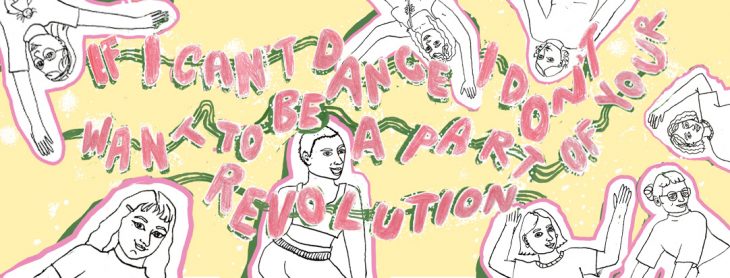
Podmladek: If I can’t dance, I don’t want to be a part of your revolution
Podmladek is celebrating its sixth year of creativity, manifested through various events and exhibitions. From one-day popups to exhibitions in various spaces and galleries, the collective members question the idea of forming groups, entering the art scene, and emphasising collective solidarity in both. This year, they are joining FeKK with a new exhibition that aligns with the festival’s maxim.
The phrase Don’t go gentle belongs to Dylan Thomas’ poem of the same title and stresses the importance of rebellion and constant battle. Podmladek responds to this title with another citation: “If I can’t dance, I don’t want to be a part of your revolution.” A quote from American anarchist Emma Goldman emphasises the belief that fighting for revolution doesn’t have to mean giving up one’s sense of playfulness. It also rejects the notion that revolutionary activism can be legitimated only through seriousness and an objectivist approach to challenging topics. The production of eight artists, who form the collective, may not initially express a directed engagement with activist themes, even though the group’s interests cover a diverse range of topics that have often encountered broader misunderstanding in the past or have been overlooked in public discourse for various reasons. In their individual practices, they often focus on the medium within which they operate, drawing inspiration from pop culture while actively exploring the broader context of the discussed themes.
Emerging from the individual’s positioning towards the world, the works of Neo Nor and Jaka Juhant are particularly focused on exploring the virtual world, where both examine its boundaries within the medium of animation. Through the eyes of Neo Nor’s protagonist, we are presented with a situation of being trapped in an environment depicted as a nightmare, exploiting their helplessness by the computer program Baba Vanga, which predicts their future; due to the prophecy, the protagonist sells their most important organ – brain(s). The animation Farmer Online narrative is built on the logic of playing a video game and draws inspiration from the intertwining of fiction and pop culture. Jaka Juhant frequently focuses on finding intermediaries to transfer an individual’s burdens to a virtual starting point. In his work titled A Day in the Life, we follow a brave knight who seems to be caught in a situation of helplessness. The author combines animation with a thoughtfully designed frame that offers a contrast between organic and technological elements. By translating the two-dimensional nature of the video into the exhibition space, the work confidently extends into three dimensions. Petra Korent‘s work Labour of Love explores themes of intimacy and partnership. Using embroidery as a technique, the author depicts an image of a couple surrounded by a meadow of various objects in an intimate moment. This image serves as a mantra, emphasising that love isn’t just given and received but requires time, effort, and work, which is expressed in various forms.
Klara Kracina delves into the theme of teenage angst, building her work around imaginative parties where the aesthetics of 1990s teenage films are reflected in piles of phones that reveal events before and after the party through message exchanges. In her piece titled Missed Calls, she directly explores the beginnings of teenage rebellion, subtly highlighting that individuals during this period of their lives often don’t consider the consequences of their actions. When I was young, I thought I could communicate with butterflies is the title of Urša Rahne‘s spatial installation, which revisits adolescence and childhood, focusing on the consequences of mistakes made during formative years. Through a humorous object that blends audiovisual segments, Rahne creates a collage of images that marked the growing-up period and were part of the child’s environment, evoking a sense of nostalgic escapism. Ema Kobal‘s work titled Movers also provides a distinct spatial intervention. The author offers exhibition space to small protagonists who use it extensively for their fictional adventures. Despite their small size, they engage in climbing walls, hanging from curtains, being surrounded by flowers, attempting to escape through nearby windows, or leaning against a wall at their leisure. While showcasing their playfulness, these micro-compositions claim space in the Project Room SCCA.
In this exhibition, the desire for collaboration within the collective extends to direct cooperation between two authors – Sangara Perhaj and Tjaša Cizej – who focus on creating a joint object. The centrepiece emerges from the exchange of the authors’ interventions on the object, which is constructed as a whole. Sitting ground is created by combining the aesthetic elements of both authors, and it is compositionally linked to Sangara Perhaj’s independent work within the exhibition frame. The infinite tug-of-war in the work Here and there! never ceases, and the rhythm of repeated movements avoids predicting the winner of the game we are watching.
As a result, the collective members appropriate the citation to address the question of resistance, which serves as the exhibition’s contextual and visual guideline. Intersecting various artistic expressions, from painting to graphic design, illustration, photography, animation, and sculpture, and drawing from various obstacles within their practice, the artists spark dialogues with one another and construct a whole unified by a collective goal — an exhibition. Each individual responds to reality with their uniquely cheerful and often distinctly humorous expression, while the exhibition takes on a quote and responds to the festival’s maxim. And like the referential poem, which is inspired by the desire to resist until one’s last breath, the collective’s urge for a community, fuelled by creative need, fights against the entropic environment to which it belongs.
Maša Knapič
PHOTOGALLERY
Exhibition opening
photo: Asiana Jurca Avci
Exhibition view
photo: Asiana Jurca Avci
The members of the collective Podmladek have been collaborating together for 6 years, engaging in joint exhibitions and simultaneously developing their individual artistic expressions. They operate at the intersection of illustration, painting, printmaking, photography, video, animation, and graphic design. Through collective exhibitions and publication releases, they aim to present their works as a group to a wider audience. In the years 2017 and 2018, they presented themselves through self-initiated pop-up exhibitions as a part of the Križevniška Street Day at the Mini Theatre in Ljubljana. In 2019 and 2020, they participated in the Dobimo se pred Škucom festival at the Škuc Gallery in Ljubljana. In 2021 they exhibited at the Media Nox Gallery in Maribor, and most recently, the collective showcased their work at the Portal 2-7-7-7-8 with an exhibition called Podmladek Photobooth.
Members of the Podmladek collective: Tjaša Cizej, Jaka Juhant, Ema Kobal, Petra Korent, Klara Kracina, Neo Nor, Sangara Perhaj, Urša Rahne.
Professional assistance: Peter Cerovšek, Vesna Bukovec
Production: SCCA-Ljubljana
Co-production: KRAKEN Association
Supported by: Ministry of Culture of the Republic of Slovenia and City of Ljubljana – Department for Culture
Thanks: Miha Zupan, Forum Ljubljana
![]()
![]()
![]()
![]()
![]()

